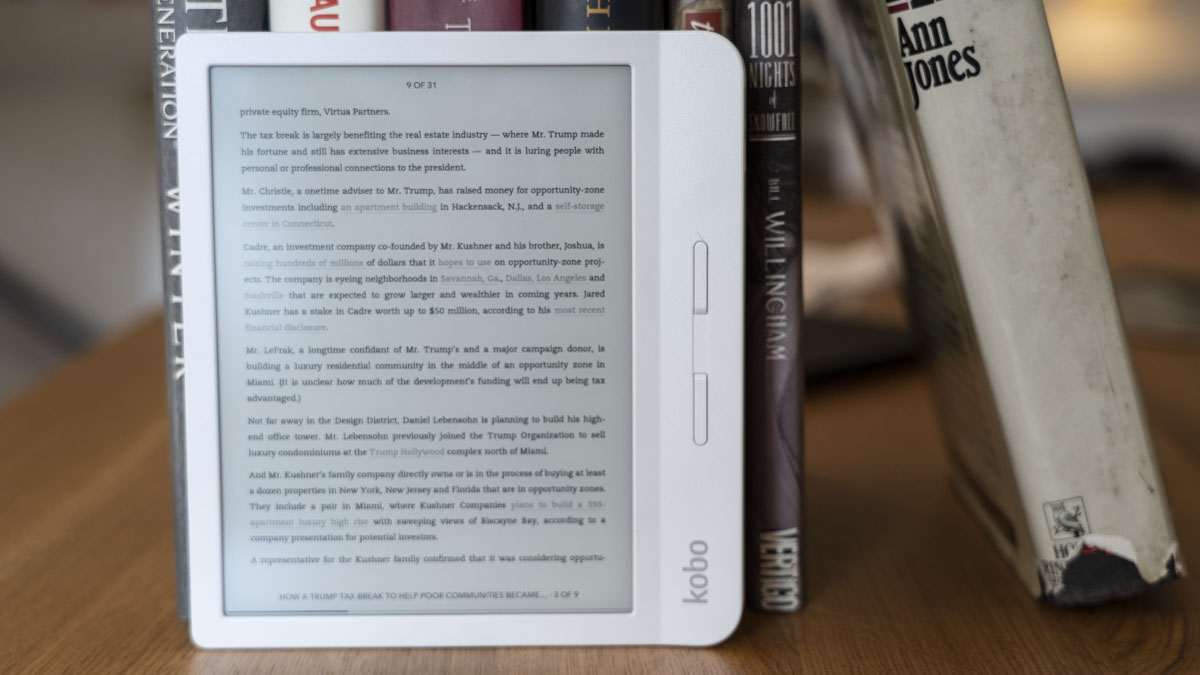We’ve mentioned it before, but here’s a gentle reminder: Amazon isn’t the only company making ereaders. Sure, Amazon has a huge chunk of the market for ebooks, and its ereaders sync seamlessly with Amazon’s services creating an addictive and difficult-to-escape ecosystem. But other companies make great ereaders that are worth considering if you’re a bookworm.
The new Kobo Libra H2O is a great example. This asymmetrical ereader will give you deja vu if you’ve been coveting the pricey Kindle Oasis. Best of all, at $US170 ($252), it’s around $150 less than the comparable Kindle Oasis (without special offers).
Editor’s Note: There is currently no Australian pricing available for the Kobo Libra H2O.
Now here is where I’m going to apologise: a lot of this review is comparing the Kobo Libra H20 to the just-launched third-generation Kindle Oasis. The two ereaders are a lot alike. Let’s cover what is different first. No Amazon integration is likely the most notable feature (or flaw) of Kobo’s new 7-inch ereader.

Kobo Libra H2O
What is it?
A pricey asymmetrical ereader from Rakuten
Price
$US170 ($252)
Like
It's inexpensive, with Pocket support, and the ability to read in landscape mode.
No Like
Feels cheaper, and the lack of Amazon support will be a bummer for Amazon fans.
There is no Whispersync to keep your reading place synced across devices, and you cannot download your whole Amazon library with a tap. (Though you can convert that library using the free application Calibre and transfer it over relatively easily.)
Japanese mega-retailer Rakuten produces the Kobo Libra H2O. So embracing it doesn’t mean you’re rejecting the kind of grotesque super-sized corporations Amazon represents.
You’re just embracing a Japanese super-sized corporation, which also has 6 million English language ebooks for sale via the Kobo store. That’s about on par with Amazon’s offering. You’ll find some books missing, and you’ll find others present (and what isn’t available you can get by using Calibre).
The Kobo Libra H2O includes native support for Overdrive, which lets you download books from your local library, and Pocket, which lets you download articles you’ve found online. Using Pocket support, I loaded up lots of articles I wanted to read, and they synced quickly to the Libra H2O, allowing me to head to the pier with plenty of reading material ready to go.
It works so well, I’d honestly maybe suggest the Libra H2O to news fans over the Kindle Oasis. As for Overdrive, it’s still possible to get library books onto your Kindle using the service, it’s just not integrated directly into the device.
Now let’s talk about what they both have. They’re both IPX8 devices, which means they can stand a quick dunk in water. They both have an asymmetrical design with navigation buttons on one side. Moving between pages is similarly speedy on both. The Libra H2O doesn’t feel quite as asymmetrical though.
It’s similar to the 8-inch $479 Kobo Forma. The backside of it is a smooth and inexpensive plastic with no real grip expressly moulded into the plastic.
The Oasis is made of metal with a very noticeable grip. Between that and the thin piece of matte glass covering the entire front of the device, the Kindle Oasis instantly feels more expensive. As it actually is more expensive, that’s probably fair.
The Libra’s power button is on the back of the device, whereas on the Kindle it’s along the edge. With the Kindle, I’ve powered it off a half-dozen times with an accidental button press. Keeping the button out of the way on the Libra is a smart move that I hope Amazon will copy.
More important than the body of the device is the display. Both share identical 7-inch e-ink displays with 300ppi. Both also have adjustable backlights with adjustable warmth that can turn the display as yellow as you so desire. It’s hard to tell the difference between them.
The Kobo device seems to have a slightly cooler display, with the backlight tending towards peach instead of an unhealthy yellow when maxed out. In practice, you won’t notice much of a difference as you can set the warmth of both devices to change at a scheduled time.
In a handy addition, the Kobo Libra H2O’s text can rotate to landscape mode. The more expensive Kindle Oasis cannot. I found myself enjoying the option, even if it truncates pages and makes paragraphs look a little unwieldy. For extended reading sessions, it’s convenient to be able to turn the device every which way.
As for which ereader is right for you? That depends on how invested in Amazon you are. If you’re regularly switching from your phone to your ereader and relying on Whispersync, or you’re too lazy to convert and move your Amazon library over, then the Kindle Oasis is probably the better option.
It also has the benefit of feeling more luxurious. But for most people, the Kobo Libra H2O seems like a much better buy. You still get the most crucial features that set this class of ereaders apart from the $199 Paperwhite — adjustable warmth, an asymmetrical design intended for easier one-handed reading — but in a much more affordable package.
README
-
About $150 cheaper than the Kindle Oasis (depending which Oasis you buy)
-
Adjustable backlight and a 7-inch 300ppi display make it easy to read
-
Can be used in landscape mode
-
No Amazon support, because duh
